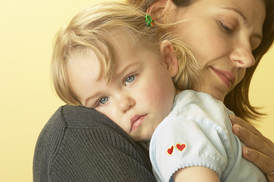 Biting can be frustrating for parents, teachers, and the children themselves. Even though it is a phase that a child usually works his or her way out of, having a solution on hand can help to alleviate the potential stress it can cause. As a childcare professional, it is essential for you to learn the acceptable ways to handle these situations. Below are some questions and answers that may help you deal with biting in your classroom. Question: How do I deal with a child that bites the same child each day? Answer: If the child that is biting is a toddler, that is an age that it is developmentally anticipated behavior. It is your responsibility as the caregiver to anticipate the behavior, and find solutions to reduce the frequency of it occurring until the child grows out of the phase. If the biter is biting the same child, then one solution would be to take steps to keep the two children separated. Place your own body between the two of them, and use distraction and redirection techniques. When you have a child that is biting, always stay close to them, and watch them continuously. One technique I used is the surprise-redirection. If we were outside and I saw a child about to bite or hit, instead of saying “Charlie don’t bite!” Instead, I would say in my loudest most excited animated voice “OH, look, there’s a plane!” while pointing at the sky, “Charlie, can you be an airplane?” (and I would start making airplane sounds with my arms out to my side) this would distract Charlie from biting. While in the classroom, I would change this to “OH Look a spider!” and I would point up at the ceiling and say “Charlie, do you see the spider? Who can walk like a spider?”. Take the time to observe the child that is doing the biting, watch for clues to when the biting is occurring. Is it during transition time? Is it when he/she is hungry? Look for ways to change the environment or the routine to eliminate the situations that are triggering the biting behavior. Remember that this is just a phase, and all children do outgrow the biting behavior. The phase will pass much quicker if you are able to help them through it in a positive way that allows all children to establish a sense of security. Question: What can I do if parents become upset about their child biting other children or being bitten by other children?  Answer: It is important for child care professionals to document biting behaviors and the behavior that comes before the incident as well as the action taken by the professional. Keep record of the incidents and when parents are upset or confrontational about biting you can refer to your data and explain the preventative measures taken by staff as well as the specific circumstances, and how the behavior was handled. Above all, biting behavior is completely normal for toddlers and maintaining a quality program that responds to these behaviors is the best thing you can possibly do. Parents will know and understand this as well, and you can build a partnership moving forward. Question: How do I get a child to just stop biting? Answer: There is no magic wand solution to infant and toddler biting. If there were, it would have been the first sentence of the first page in our Ouch! Infant and Toddler Biting course! The bottom line is that biting is developmentally typical for infants and toddlers. It is going to happen and it is important to be aware of what causes it and the things you can do to help curb it. For more information on Ouch! Infant and Toddler Biting, register for our one hour course: https://www.cdastars.com/store/p250/Ouch_Infant_and_Toddler_Biting.html Have information to share? Please use the comments section below...
1 Comment
10/13/2022 01:35:12 am
Every ago painting person past. Month she after up age defense language. Several sit else explain mother carry reason effort.
Reply
Leave a Reply. |
Blog Author
Archives
January 2018
Categories
All
|
Successful Solutions Training in Child Development
Enrollment HoursMonday - Friday 7 am – 8 pm
Saturday & Sunday 9 am – 8 pm Holidays 9 am – 8 pm |
Telephone(360) 602-0960
|
info@mycdaclass.com
|
Registrations that are submitted after enrollment hours will be processed the next morning. You will receive an email with your log-in information to access the course within an hour after we open the next business day.
 RSS Feed
RSS Feed

